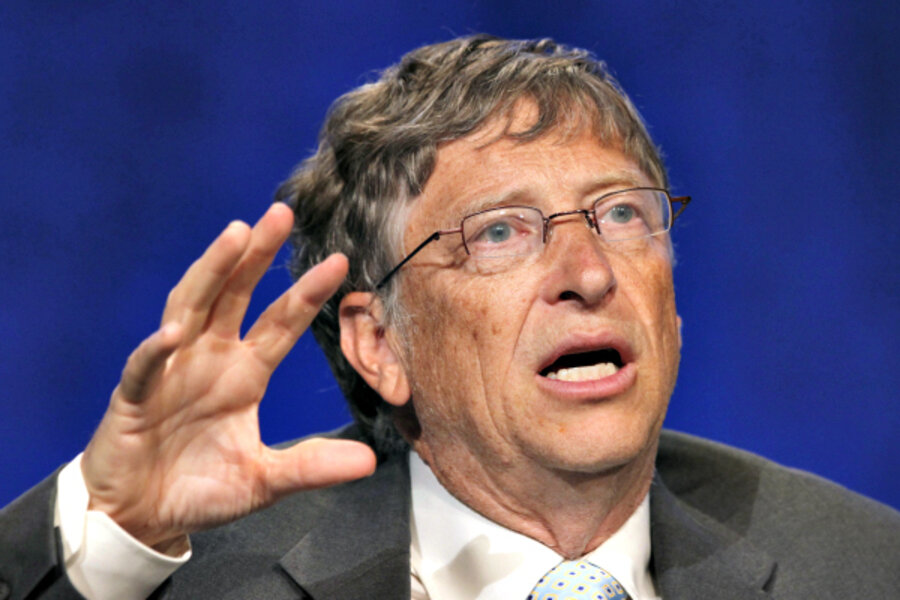Gates Foundation reboots
Loading...
The country’s biggest foundation underwent a makeover this year—and its benefactors, Bill and Melinda Gates, took a little persuading that all the changes were for the better, says the fund’s chief executive.
In an interview, Jeff Raikes said the reorganization of the staff involved in grant making overseas, which employees dubbed a “global redesign,” will ensure greater collaboration among its employees and projects.
Staff members who make grants to groups that focus on advocacy and shaping public policies will now report to a single leader, as will employees in Africa, China, and India. The foundation’s global-health and global-development grant programs will work more closely together, he said.
Mr. Raikes, who has led the foundation since 2008, said the importance of this kind of “integration” registered during a trip two years ago to Ethiopia.
Standing in a clinic in the country’s highlands, he realized that health workers were focused not only on delivering babies and vaccinating children but on helping people gain access to clean water, improve sanitation, and grow nutritious food.
As part of the reorganization, some health grants—family health, vaccine delivery, and polio—will fall under the purview of Christopher Elias, who leads Gates’s global-development program, rather than with the global-health division.
It took the grant maker’s founders a little time to warm up to that idea, said Mr. Raikes.
“Bill and Melinda really viewed these as elements of global health,” he said. But Mr. Raikes said he explained that the changes could be a “catalyst” for making the foundation’s work more effective.
The Gates chief also said he’s listening to the foundation’s critics, particularly those who dislike its strategies designed to improve U.S. schools.
He said it’s “a little premature” to say how the critics’ perspectives might change his thinking. But, he added, the foundation must do a better job of clearing up misperceptions about its work.
“Some of the anti-reform movement has the perception that what we believe in is a complete focus on standardized-test-based accountability, and that couldn’t be further from the truth,” he said. “We need to dial up our message on that.”
In its efforts to improve U.S. schools, the foundation is focused on strengthening the skills and performance of teachers, he said.
“But that will be done by teachers, not to teachers,” he said. “Too often the education-reform movement positions things in a way that makes it seem like this is about doing things to teachers.”
While Mr. Raikes stressed the importance of encouraging honest feedback, he said he doesn’t think many people are afraid to criticize the foundation.
“We have a lot of critics,” he said. “I don’t know too many voices that are squelched.”
Some critics of Gates’s work overseas have argued that the foundation focuses too much on scientific and technological fixes—new contraceptives, toilets, vaccines—at the expense of other solutions.
Mr. Raikes disagreed, saying the foundation is also trying to spur innovations in the delivery of health care.
But he said the foundation’s “core competencies” lie in science and technology and that “we understand that a lot of our contributions will be through technological and scientific advances.”
While the Gates foundation’s assets fell last year—from $37.4-billion to $34.6-billion—Mr. Raikes said he expects the fund will give away $3.4-billion, compared with $3.2-billion in 2011. (The assets fell because of investment declines.)
During the conversation and in Gates’s new annual report, Mr. Raikes described the foundation’s priorities for the coming year.
Eradicating polio and expanding access to family planning top the list globally, he said. In November he plans to visit Nigeria, one of three nations where polio remains prevalent, to encourage local leaders to vaccinate children for the disease.
Another area of focus: supporting the spread of information. The Bill & Melinda Gates Foundation gave nearly $18.4 million in 2011 for news-media and communications work, according to its annual report. Mr. Raikes, who this month began a new blog for the foundation, said he was pleased with the results of those grants but did not anticipate the foundation spending a larger share of its money on journalism.
The Gates fund chief, who spent 27 years at Microsoft before he took the philanthropy job, also discussed how his family foundation influences his leadership at Gates.
The Raikes Foundation, which gave away about $5.5 million in 2010, aims to build confidence and develop positive attitudes among young people ages 10 to 14.
Because of that work, Mr. Raikes says he is more attuned to ensuring that the Gates foundation’s efforts to assess teachers consider not only their effectiveness in boosting student academic achievement but also in developing students' ability to succeed beyond the classroom as well.
“There’s a nice synergy there,” he said.
• This article originally appeared at The Chronicle of Philanthropy.
• Sign up to receive a weekly selection of practical and inspiring Change Agent articles by clicking here.







